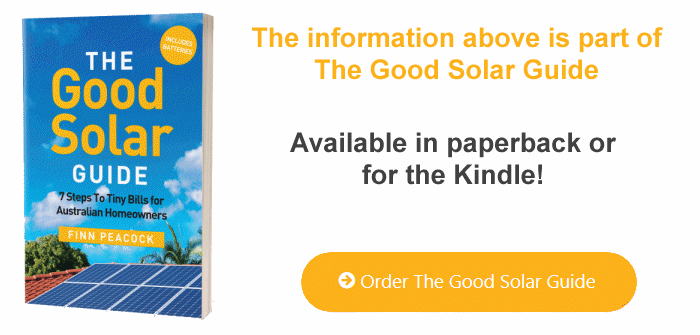CONCLUSION: Beyond Solar
← Solar Systems Maintenance | The Good Solar Guide Contents
You’ve followed the seven steps. You’ve done your homework and if you decided that a solar power system is a good investment, you’ve engaged a good installer and filled your roof with solar panels. You’ve shifted your loads and found a solar-friendly electricity retailer, and your bills are nice and low. You know your system will alert you if there’s a problem. You’re starting to look forward to electricity bills rather than dreading them.
That’s a great place to be – so what’s next?
Efficiency
If you have solar panels, your bills should have dropped significantly. If you have an efficient home, you really should be looking at close to zero dollars in summer and $100 to $200 per quarter in winter. If you’re paying much more than that, you’re using more energy than you have to during non-daylight hours. The trick to even smaller bills for you is energy efficiency, especially in the thermal performance of your home – how you heat and cool it.
I could write a whole book on efficiency. Luckily, I don’t have to, because there’s a brilliant one already available. If you think your home could be more efficient and you want to shave the last few hundred dollars off your bill, buy this book: The Energy Freedom Home, by Beyond Zero Emissions.
Batteries
Batteries are going to be huge. Storing electricity is the secret to making intermittent renewables (like solar energy) our main source of energy. As explained in Step 4, batteries aren’t yet a good economic investment for the typical Australian and they’ll increase the carbon footprint of most homes16.
This will change in the future when battery prices drop and we can’t connect any more renewables to the grid without adding batteries.
When batteries make sense economically or environmentally, I’ll let you know. You can subscribe to updates on my blog here: solarquotes.com.au/subscribe.
If you want a battery despite the marginal economics, good on you. You’ll be helping the burgeoning home-battery industry and you’ll enjoy the peace of mind of blackout protection. Just re-read the advice in Step 5 before you get your quotes.
Cars
Once you’ve got rid of most of your electricity bill, you should think about your fuel bills.
At the time of writing, I believe we’re on the cusp of a revolution with electric cars. If your car has another three or four years left in it, consider hanging on to it a little longer. By then, I’m predicting that electric cars will be a no-brainer for anyone with a big solar system. Beware of buying an expensive new oil burner that no one wants to buy in a few years because everyone wants electric.
What not to do
In energy, the future is approaching at breakneck speed. You have a choice.
Choice 1: Do nothing
The fact that you’ve got to the end of this book tells me that you’re not a ‘do nothing’ type of person. You have all the knowledge you need to decide if solar power is a good investment for you. The worst case is that you’ve discovered your roof isn’t solar-friendly because there’s too much shade or it’s a really weird shape.
In that case, I strongly recommend working through the Energy Freedom Home book I linked to earlier in this chapter to make your home as efficient as possible. Keep your ear to the ground for ‘community solar farms’, where you can buy solar panels elsewhere and use their output to credit your bill. They’re coming soon.
If you’re moving to a new house before the solar will pay for itself, I urge you to make a solar-friendly roof a priority when looking for a new home.
Choice 2: Act now
For the rest of you, with solar-friendly roofs that you’ll own for the foreseeable future, get started right now. Go back to Step 2, print out the worksheet and take your first meter reading this Sunday. That’s the first small step towards a future where you take responsibility for your energy generation and consumption.
Once you’ve measured your energy profile, use the free tool I provided to estimate how many solar panels you can fit on your roof.
That same tool will estimate a financial return for a roof full of solar based on the usage profile you’ve measured.
Then use one of the methods I suggested to get three quotes for high-quality solar. If you can afford it, err towards the quality end of the hardware choices.
Talk your options over with your solar installer. Discuss how you’ll handle your hot water and where a future battery could go. Make sure the installer’s payback projections match the ones you worked out yourself.
If you want to finance the system, avoid the ‘no-interest’ options and go for a realistic low-rate loan where the repayments are less than the savings.
Then if all the ducks line up, pull the trigger and get a solar power system installed.
The security of low bills for decades, the comfort of cranking the air conditioning and not worrying about the bills, and the satisfaction of offsetting the bad energy choices of our pollies and business leaders all make you feel great. Now you’ve taken the time to learn about the critical aspects of the energy revolution, you can be confident that you’ll benefit from the technology, rather than becoming a victim of energy companies’ profiteering or politicians’ fearmongering.
A final note
As I write the final words of this book, an episode of 60 Minutes was just shown on Channel 9 about Australia’s energy crisis. In it they interviewed our Federal Minister for Energy, Josh Frydenberg, who revealed that he has large electricity bills every quarter and it really puts a dent in his household budget. The presenter asked him if he had solar panels on his home. He replied that he doesn’t because he thinks it’s expensive. Apparently, the guy who makes the energy investment decisions for Australia is not aware that buying good solar on low-cost finance is almost always cheaper than paying electricity bills.
Don’t be like Josh. Now you’ve read this book, you know much more about the practicalities and economics of buying solar than he does. If you ever get interviewed on 60 Minutes about your electricity bill, instead of looking glum and complaining about a large invoice every three months, you can happily explain that you don’t worry about your electricity bills anymore because you did your homework and you have a great value solar system on your roof. A solar power system that will provide the security of low bills for decades, no matter how badly the pollies screw up the energy system.
16www.solarquotes.com.au/batteryfootprint
Acknowledgements
Thanks to my Mum, Pirkko Carpenter, for instilling a love of both books and nature, and putting the fire in my belly.
Thanks to Ronald Brakels, for help with the words.
Graphs for the quote section were inspired by Warwick Johnston’s excellent PVSell software.
The Author
Finn is a Chartered Electrical Engineer who lives in Adelaide in a solar home made of straw. His last quarterly power bill to power a family of five, a small business and an 8 kW Finnish sauna was a credit of $128.
Finn is the founder of SolarQuotes®, Australia’s most popular solar website which, since 2009, has arranged solar quotes for over 350,000 Australians.
Before he founded SolarQuotes®, Finn worked for CSIRO, commercialising their solar and energy efficiency technology.
Find out more at www.solarquotes.com.au [email protected]
← Solar Systems Maintenance | The Good Solar Guide Contents
Questions or feedback about the content on this page? Contact me.

